Everybody remembers the story of Bambi, the young deer whose mother get shot dead by hunters, and his rabbit friend, Thumper. In Disney animation these creatures are fine but put Bambi and Thumper in your garden, and you wish that they were never born.

Plants can be devastated by rabbits and deers who have a large appetite for many plant varieties. It is a nightmare trying to come up with plants that are not favoured by deer and rabbits, and yet still attractive to have in the container garden.
DEERS AND RABBITS WILL EAT ANYTHING
In very harsh weather conditions, when the deers and rabbits are very hungry and are finding few pickings, they will eat almost anything. Trying to find a plant that can survive deer or rabbit attacks are very limited, but the plants suggested in this post are both deer and rabbit resistant plants, but are attractive and can be grown in containers.
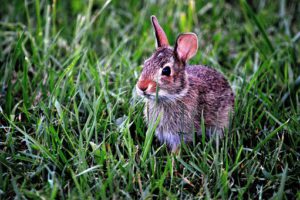
There is no guarantee that these suggested plants will not be damage free in all conditions, especially in spring where the tender new green shoots proving tempting to deer and rabbits. One way to circumvent this is to look at your neighbours’ gardens in the area that you live and see what plants have not been devoured and instead are flourishing. Make a list of those been eaten and those which have been left alone, and use that in your container garden
TREES AND SHRUBS
This is the largest category of plants, which offer some protection from deer and rabbit attacks. These include:
AUCUBA (Spotted Laurel)
These hardy shrubs such as aucuba Japonica brighten up all autumn, winter and spring containers. In autumn, the glossy yellow splashed leaves can be under planted with red or pink cyclamens or combined with flame or lime green coloured plants.
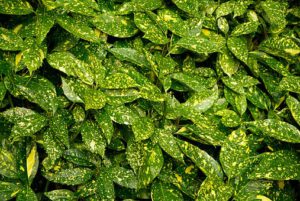
This unfussy hardy shrub requires little maintenance. It prefers well drained, gritty compost in light shade.
BUXUS (Box)
These evergreen shrubs, with their small leaves, make such great topiary features in the garden, especially close to your front door. These plants like rich compost and a regular feed in spring.
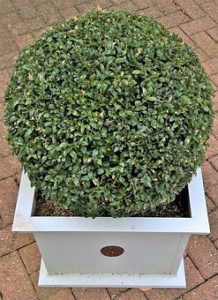
It needs to be repotted every 2-3 years in order to avoid the plant becoming root bound. You also need to watch out for box blight and this can kill box within a few growing seasons, and little treatment is effective.
CHOISYA TERNATE (Mexican Orange Blossom)
It is a hardy relative of the citrus family as it has similarly aromatic leaves, and sweet smelling, waxy textured flowers. It does not mind being pot bound, and in full sun surrounded by other Mediterranean plants, will create your own piece of Riviera on your patio.
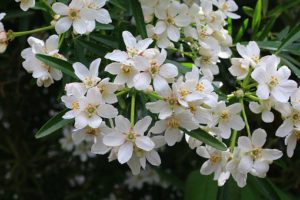
It also does not mind shade so it can be seen as a dual-purpose plant. It likes fertile, well-drained compost, preferably in full sun. They do not like cold winds, so wall protection may help. Watch out for slugs and snails.
FATSIA JAPONICA (False Castor Oil Plant)
Place these large, glossy plants in the shade, because they will reflect the light well. As the plant ages, it may produce branched flower stems in autumn with spherical flowers.

These flowers turn to black berry-like fruit. Be careful as late spring frost may damage young shoots and leaves, but a mature plant will recover quickly. Remove dead leaves to make plants look tidier.
FUCHSIA MAGELLANICA (Fuchsia)
This is a large, fully hardy tropical looking shrub that flowers from early summer to well into autumn. It makes a suitable specimen when planted solely in a container.
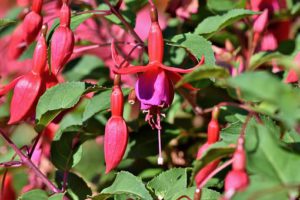
Do not confuse this plant with other varieties of fuchsia that are suited for hanging baskets. You need to watch out for aphids, red spider mites, vine weevils, rust and grey mould. Yellow leaves and brown spots are a sign of overwatering and/or poor drainage.
GAULTHERIA
The dark evergreen foliage of this prickly shrub comes to life in late summer and autumn when the large spherical white, pink or red berries ripen. They love acidic soil and prefers a male specimen to be close by to facilitate the production of berries.

The plant prefers the shade, and to be grown in ericaceous compost. You need to remove any suckers or the plant will grow very big. The shrub tends to be unaffected by diseases and pests.
ROSMARINUS (Rosemary)
There are a number of varieties that are grown for their rich, green aromatic leaves and its blue flowers. The most hardy is ‘Miss Jessop’s upright’ but use’ Benenden Blue; for its attractive flowers.
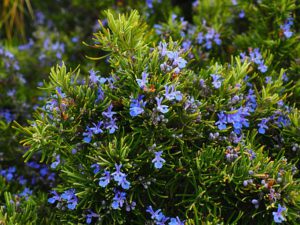
‘Primley Blue’ also grows upright, whilst ‘McConnell’s Blue’ has a carpeting effect. Like all herbs, Rosemary like free-flowing gritty/sand mixed with compost in full sun. It is a plant that will look after itself, but honey fungus can become a problem.
ROSA (Rose)
You can grow many miniatures and patio roses in containers, with their small cluster type flowers, produced over a long period of time. Look for varieties with no black spot or rust. Miniature roses do best in containers, and miniature climbing roses can be used against a bare wall.
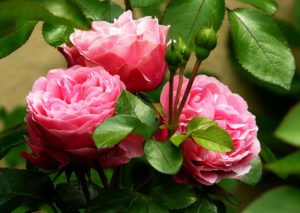
For deer protection make sure a spiky species is used, otherwise, they will devour the flower heads. Roses are hungry plants and so need a fertile, moisture retentive compost. Feed at regular intervals and water regularly. In order for the plant to produce it needs to be deadheaded frequently, and yellowing leaves to be removed.
SKIMMIA
Some of the most striking plants found in autumn are the Skimmia Japonica, a compact evergreen shrub that have male or female flowers. Males have crimson red flowers arranged in cone shape clusters that resemble tiny berries.
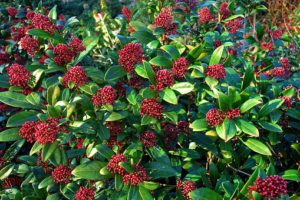
When skimmia flowers in spring, the scene is purely divine. The female produces berries in winter but most people by males for the display. They prefer ericaceous compost that is moist and free flowing. Feed regularly with liquid fertilizers.
SYRINGA (Lilac)
These shrubs provide structure and continuity throughout the year, with little effort from the gardener. These plants look good in wooden barrels covered in bark chippings.
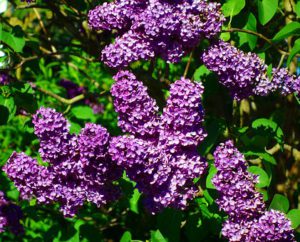
They flower from late spring to early autumn and have a delicate smell. For best results, use loam based compost and mulch to retain moisture.
VINCA (Lesser Periwinkle)
This trailing plant hanging over a container or hanging basket makes a great alternative to ivy. The leaves are narrow, leathery that are all green, white or gold colour.

You need to watch out for die back and cut it out immediately. Do not mulch as this can cause the crown of the plant to rot. Otherwise, maintenance free.
YUCCA (Adam’s Needle)
These striking plants get their common name based on the leaves that come to a sharp point. Be careful when around children as the plant leaves are sharp. This Mediterranean type of plant looks outstanding in any garden container.
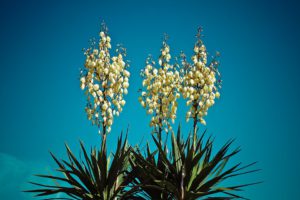
It takes at least two years before Yucca’s become established enough to flower. The flowering stem needs to be removed after flower to prevent diseases such as leaf mould. These plants are also attacked by aphids.
PERENNIALS
There are only a few perennials that can be grown in containers and are deer/rabbit proof. This includes:
BERGENIA (Elephant’s Ears)
This is an evergreen perennial that looks better in winter, but these large oval leaves take on rich colours once the temperature starts to drop. Any Bergenia can be grown in containers but the dwarf variety ’Wintermarchen’ is preferred.
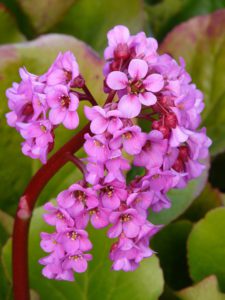
The plant like moisture retentive humus-rich compost, by regular feeding and watering during summer.
GERANIUMS (Cranesbill)
These herbaceous perennials come in compact alpines that are suitable for growing on containers permanently, because of the lobed leaves and abundant blooms.
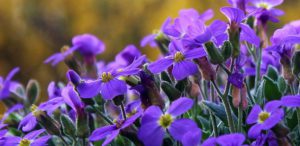
Geraniums thrive in sunny spots when planted in moisture retentive loam. Need general fertilizers once a month.
HELMEROCALLIS (Day Lily)
This hardy perennial has sword-like foliage, with upright stems that have sculptured flowers. They can flower repeatedly from late spring to late summer.
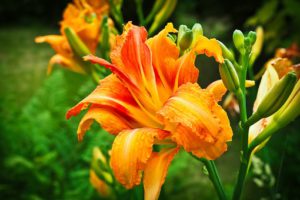
The common name comes from the fact each bloom lasts a day, some open in late afternoon and last the following day. This plant rarely needs staking and therefore good in windy gardens. They prefer humus rich compost that retains moisture. Water freely in summer.
SEDUM (Stonecrops)
Many sedums can be grown in pots, as they are drought resistant plants and are very adaptive to the growing conditions. This makes them suitable in containers as they do not mind if the container dries out quickly.
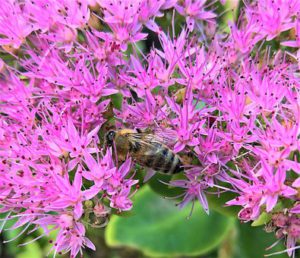
The problem many of these stonecrops are attractive to deers, apart from sedum spectabile. This plant looks outstanding in a container. Sedums prefer well-drained compost in a sunny, ventilated position. Watch out for slugs and snails.
CLIMBERS
The only clematis that can be grown in a container that offers some protection from deer/rabbit attacks. Compact varieties make excellent container subjects. They are normally trained up tripods, obelisks, or topiary frames. You can also train them to grow up fences, walls and trellises.
You need a large, wide pot such as a wooden barrel. You need to plant deep around 10cm below the surface of the compost. This is done to encourage new shoots to grow from below compost level, which thickens the plant to cover a greater area on the growing media.
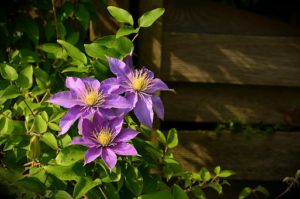
When training the new shoots over a framework, try to encourage the stem to grow closer to the horizontal as a means of promoting abundant vertical shoots.
The container needs to be mulched with bark chipping to prevent moisture loss and to protect the roots. Clematis do not like the sun shining on the base of the plant, and so prefers the root area to be shaded. Remember clematis likes it head in the sun but its feet in the shade.
MECHANICAL PROTECTION
If you want to grow more varieties of plants in containers that will not be attacked by deers or rabbits, then a mechanical means may be attempted, such as a ‘Jet Spray Animal Repeller’. It does not harm the animals, but sprays jets of water when an animal is detected nearby.
It has the added benefit as it can also be used for cats and dogs that visit your garden. The device is battery operated and so can be moved to any part of the garden. You can also try fencing off your garden, but remember deers can jump quite high, and so a tall fence, preferably electrified will be required.
CONCLUSIONS
In this article deer and rabbit proving your container garden has been discussed, with a selection of plants that can be used recommended. If you have any question or comments, please do not hesitate to leave a comment below, where I will reply to you in due course.
Keep Gardening.


Although I am not a gardener at heart, I do appreciate the time you took to write this article. I had no idea that deers and rabbits would eat almost everything in their path. This is a “pretty” list of flowers and plants that they will avoid.
What about herbs and spices? I use a lot of basil because it is great for diabetes. Will they let it be? Thanks and all the best.
Thank you for your comments Josephine
In future articles, I will be discussing herbs that can be grown in pots, and this will include basil, rosemary, thyme, sage etc. So keep your eyes open for this.
Antonio
Throwing your neighbors out to the Deer (wolves) lol just kind of struck me funny I guess but good advice. One of my favorite trees/plants is the Lilac, I wish they lasted longer though.
How do these plants protect against Deer and Rabbit, are they poisonous to them? Also are there two sets of these plants and shrubs that would hinder the growth of each other?
Hi Amanda
The simple answer to your question is that they are not necessarily poisonous to them but they simply do not like the taste of them.
As these plants will be grown as individual specimens in containers then there will be no hindrance to their growth, which is the beauty of container gardening, The plant does not necessarily need to compete for nutrients or water.
Thank you for your interest.
Antonio
Living in the mountains here in Virginia, a lot of people like to grow their gardens. Many have a problem with deer and other critters eating their plants. They also put electric fences to keep the critters out. I wish I could grow flowers in my yard but my soil is mainly made of rock. Therefore, I have hanging plants both inside and outside my home. You show a beautiful selection of flowers and I just may have to look into getting some of them. I might even check back on what you post on herbs. Thank you for sharing!
Hi Angela
Thank you for the kind words and you are more than welcome to visit my site at any time. Yes, deers and rabbits can devastate a garden literally in a day, so these pests need to be discouraged and this is why these plants have been suggested.
Thank you for your interest
Antonio
I know that deer eat anything but I wasn’t aware that rabbits did too.
We are planning a garden and it’s good to know how to rabbit proof our garden.
While we don’t have deer where we are, there could also be other animals that could ruin our garden.
I’m glad you suggested plants that they may not bother because that’s a big plus before we start our garden.
Is there any other way to deter them from coming near the plants?
Hi Rob
Thank you for those kind words. If you really want to deter deer or any other animals from entering your garden, you need to use a high electrified fence. This will keep animal out but you in.
Thanks, once again
Antonio
Thank you for sharing such a detailed post on rabbit and deer proofing a garden. It’s spring and time to get outside for some fresh air. You included a lot of plants and I see there are quite a few evergreens on your list.
I didn’t know that there are roses without thorns. Roses are good to have in the garden.
Lilac is one of my favorite because of the color but the smell can be strong.
What are signs of honey fungus that I should I look out for on ROSMARINUS (Rosemary)? And is this the kind of Rosemary you can cook with?
Hi LeNard
Thank you for those kind words about my article. Homey fungus looks like a normal mushroom-like grown from the rosemary’s trunk. And yes it is the same plant as the one you cook with, especially roasted with lamb.
Thanks
Antonio
Great article there Antonio, I really love to own a garden in my own house one day. I am sure this article will serve as a guide to me. I really love a compound with a garden and I personally love the Sedum. will start from there.
Hi Lerakinz
Thank you for the kind words, and when you get your own garden you will know where to come back to get some more advice.
Thanks
Antonio
I have plenty of deer and rabbits around the yard. The rabbits nest in the boxwood bushes in the front yard. The deer live in the woods beyond the fence in the back yard. Keeping them out of the plants has been a problem. I have a dogwood tree that is in the corner growing over the fence, it is full of buds this year, I hope they do not eat them before they bloom.
I do container some of these flowers already with a lot of success. Elephant Ears, Geraniums, Vincas and some vegetables are grown on my deck in containers.
I have the Roses, Yuccas, Day Lilies, Boxwoods and Mint that seem to do well planted in the earth. I have a different plant next to the rose in the front yard and the deer were eating away at this plant right outside my front door, they left prints in the snow.
Thanks for the good information on what to put in my container garden this year, does any veggies do better than others.
John
Hi John
Thank you for your kind words. It is always of interest to extend your range of plants in your garden, especially containers. I am going to write an article soon about the veg you can grow in containers. Look out for it
Kind Regards
Antonio
I thought hostas were deer resistant for years until mine needed thinning out and I started to move them further away from the house. Critters ate all of the plants that I had grown out in the yard but they didn’t touch the ones by the house. This year, I am planning to move what I can closer to the house and give the others away. It’s great to know that there are some alternatives.
Hi Theresa
Thank you for the kind comments. All the plant that I recommend offer some deer resistance but they are not fool proof. The plants are elegant even if you don’t have a deer or rabbit problem.
Thanks
Antonio